Developing Manager Report: A Comparative Analysis of Leadership Styles
VerifiedAdded on 2020/02/14
|19
|5856
|148
Report
AI Summary
This report provides a detailed analysis of leadership and management styles, focusing on the contrasting approaches of Virgin Group and Ryanair in the travel industry. It begins with an introduction to the crucial role of managers and the importance of strategic management in today's competitive environment. The report then delves into different management theories, specifically comparing coercive and active management styles, and how they are exemplified by the CEOs of Ryanair and Virgin Group, respectively. The report explores leadership characteristics, communication strategies, and organizational culture within these two companies. It examines the impact of leadership styles on employee motivation, decision-making, and organizational success. The analysis covers communication processes, highlighting the differences between downward and open communication systems. Finally, the report discusses organizational culture, comparing clan and hierarchical cultures, and their alignment with leadership and management styles. The report concludes by offering insights into how a blended approach to management could be beneficial, and makes recommendations for leadership development.
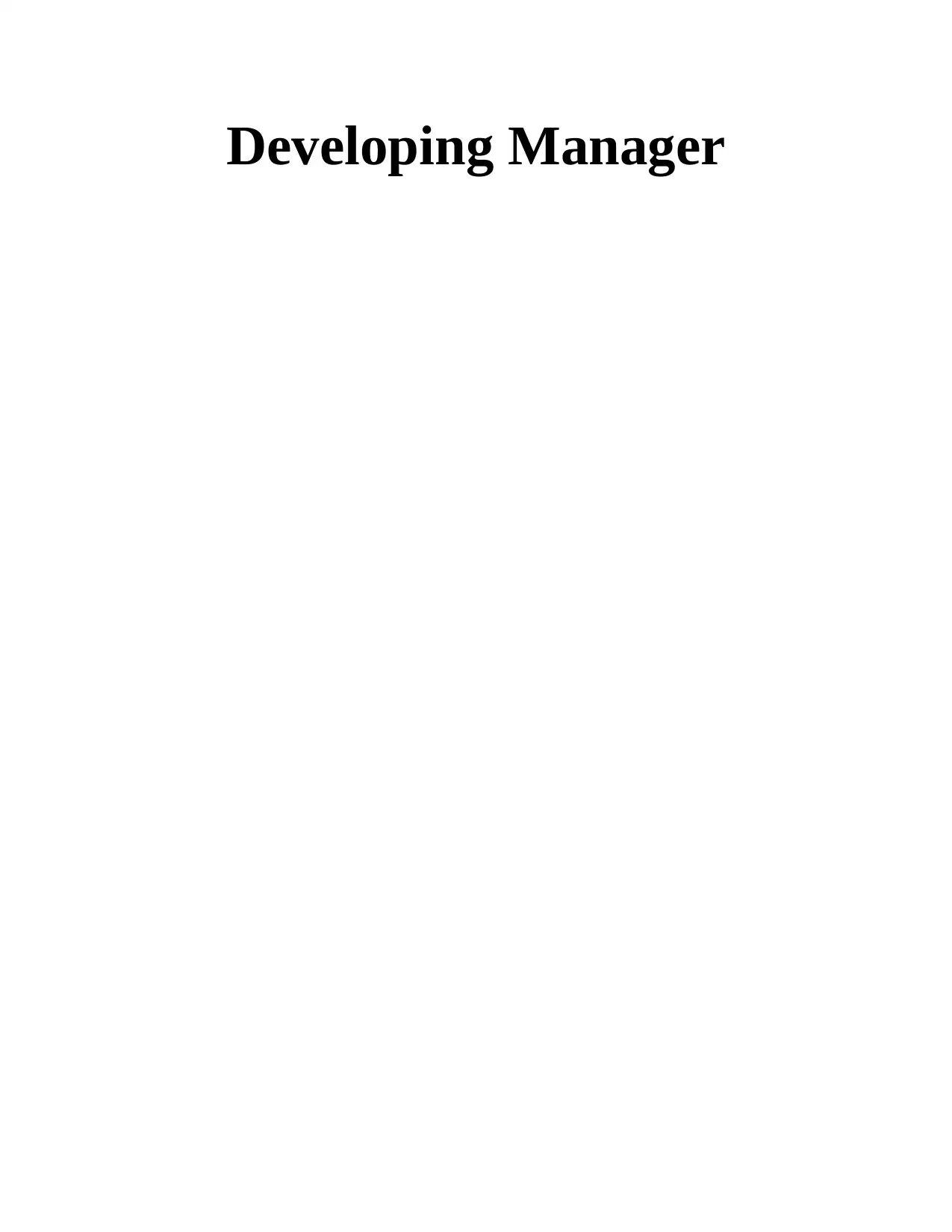
Developing Manager
Paraphrase This Document
Need a fresh take? Get an instant paraphrase of this document with our AI Paraphraser
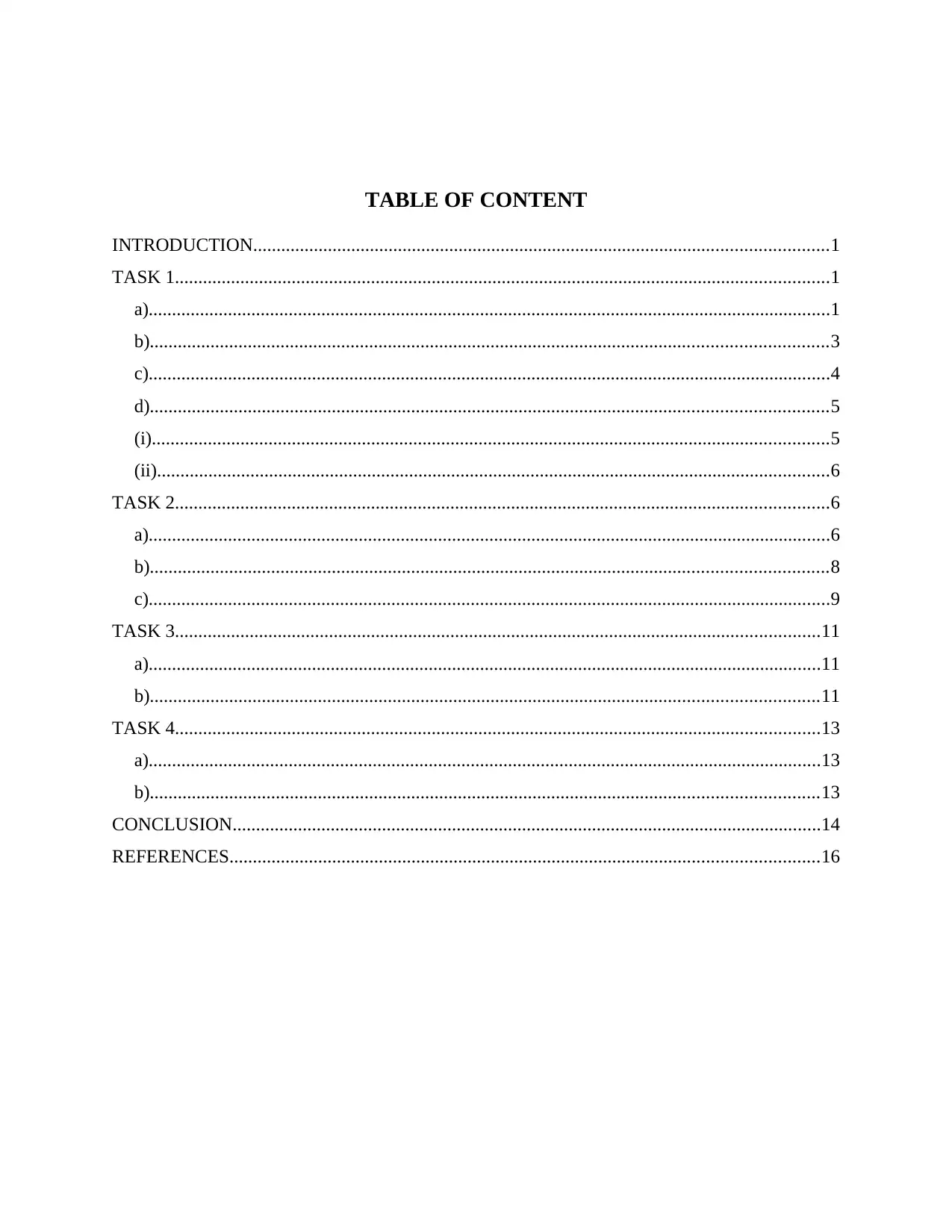
TABLE OF CONTENT
INTRODUCTION...........................................................................................................................1
TASK 1............................................................................................................................................1
a)..................................................................................................................................................1
b).................................................................................................................................................3
c)..................................................................................................................................................4
d).................................................................................................................................................5
(i).................................................................................................................................................5
(ii)................................................................................................................................................6
TASK 2............................................................................................................................................6
a)..................................................................................................................................................6
b).................................................................................................................................................8
c)..................................................................................................................................................9
TASK 3..........................................................................................................................................11
a)................................................................................................................................................11
b)...............................................................................................................................................11
TASK 4..........................................................................................................................................13
a)................................................................................................................................................13
b)...............................................................................................................................................13
CONCLUSION..............................................................................................................................14
REFERENCES..............................................................................................................................16
INTRODUCTION...........................................................................................................................1
TASK 1............................................................................................................................................1
a)..................................................................................................................................................1
b).................................................................................................................................................3
c)..................................................................................................................................................4
d).................................................................................................................................................5
(i).................................................................................................................................................5
(ii)................................................................................................................................................6
TASK 2............................................................................................................................................6
a)..................................................................................................................................................6
b).................................................................................................................................................8
c)..................................................................................................................................................9
TASK 3..........................................................................................................................................11
a)................................................................................................................................................11
b)...............................................................................................................................................11
TASK 4..........................................................................................................................................13
a)................................................................................................................................................13
b)...............................................................................................................................................13
CONCLUSION..............................................................................................................................14
REFERENCES..............................................................................................................................16
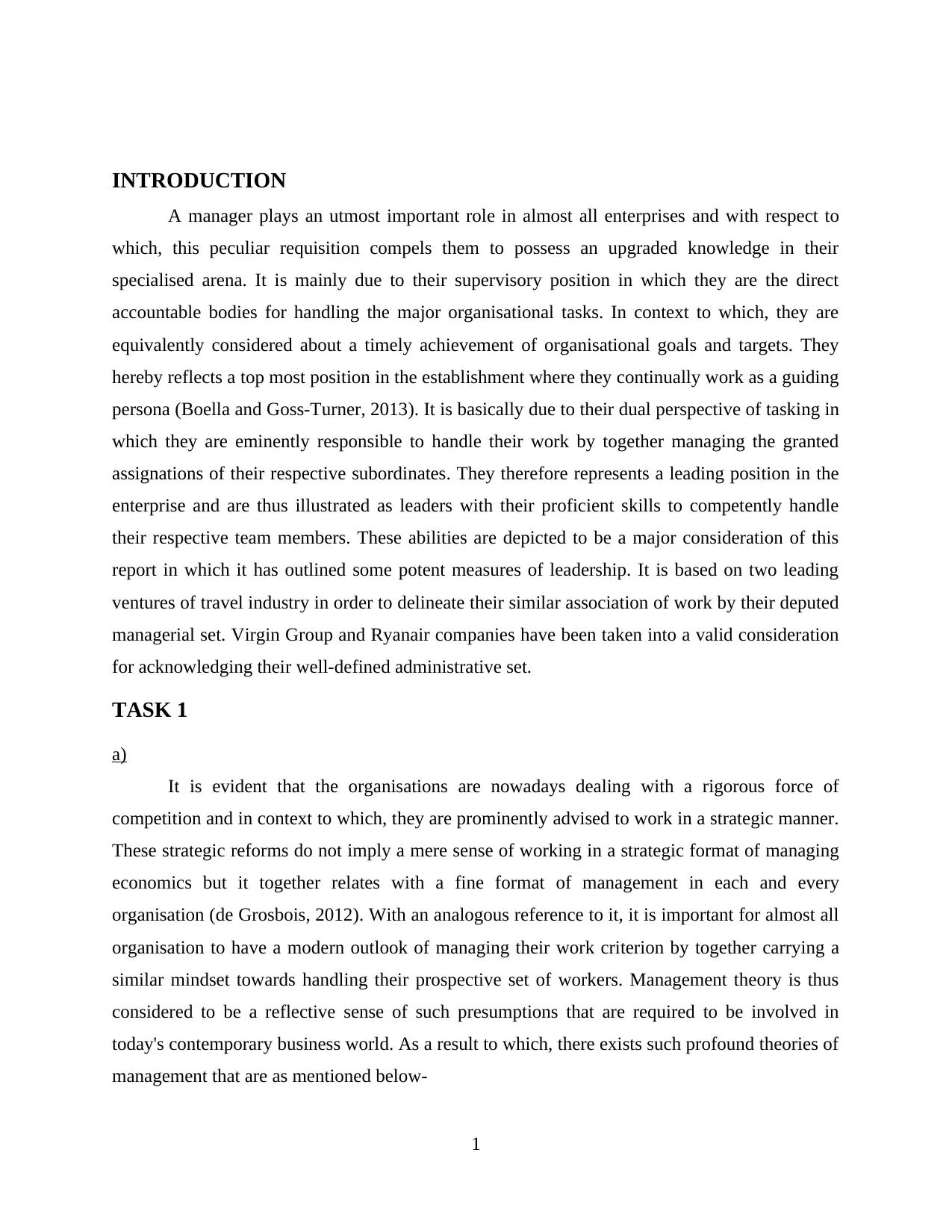
INTRODUCTION
A manager plays an utmost important role in almost all enterprises and with respect to
which, this peculiar requisition compels them to possess an upgraded knowledge in their
specialised arena. It is mainly due to their supervisory position in which they are the direct
accountable bodies for handling the major organisational tasks. In context to which, they are
equivalently considered about a timely achievement of organisational goals and targets. They
hereby reflects a top most position in the establishment where they continually work as a guiding
persona (Boella and Goss-Turner, 2013). It is basically due to their dual perspective of tasking in
which they are eminently responsible to handle their work by together managing the granted
assignations of their respective subordinates. They therefore represents a leading position in the
enterprise and are thus illustrated as leaders with their proficient skills to competently handle
their respective team members. These abilities are depicted to be a major consideration of this
report in which it has outlined some potent measures of leadership. It is based on two leading
ventures of travel industry in order to delineate their similar association of work by their deputed
managerial set. Virgin Group and Ryanair companies have been taken into a valid consideration
for acknowledging their well-defined administrative set.
TASK 1
a)
It is evident that the organisations are nowadays dealing with a rigorous force of
competition and in context to which, they are prominently advised to work in a strategic manner.
These strategic reforms do not imply a mere sense of working in a strategic format of managing
economics but it together relates with a fine format of management in each and every
organisation (de Grosbois, 2012). With an analogous reference to it, it is important for almost all
organisation to have a modern outlook of managing their work criterion by together carrying a
similar mindset towards handling their prospective set of workers. Management theory is thus
considered to be a reflective sense of such presumptions that are required to be involved in
today's contemporary business world. As a result to which, there exists such profound theories of
management that are as mentioned below-
1
A manager plays an utmost important role in almost all enterprises and with respect to
which, this peculiar requisition compels them to possess an upgraded knowledge in their
specialised arena. It is mainly due to their supervisory position in which they are the direct
accountable bodies for handling the major organisational tasks. In context to which, they are
equivalently considered about a timely achievement of organisational goals and targets. They
hereby reflects a top most position in the establishment where they continually work as a guiding
persona (Boella and Goss-Turner, 2013). It is basically due to their dual perspective of tasking in
which they are eminently responsible to handle their work by together managing the granted
assignations of their respective subordinates. They therefore represents a leading position in the
enterprise and are thus illustrated as leaders with their proficient skills to competently handle
their respective team members. These abilities are depicted to be a major consideration of this
report in which it has outlined some potent measures of leadership. It is based on two leading
ventures of travel industry in order to delineate their similar association of work by their deputed
managerial set. Virgin Group and Ryanair companies have been taken into a valid consideration
for acknowledging their well-defined administrative set.
TASK 1
a)
It is evident that the organisations are nowadays dealing with a rigorous force of
competition and in context to which, they are prominently advised to work in a strategic manner.
These strategic reforms do not imply a mere sense of working in a strategic format of managing
economics but it together relates with a fine format of management in each and every
organisation (de Grosbois, 2012). With an analogous reference to it, it is important for almost all
organisation to have a modern outlook of managing their work criterion by together carrying a
similar mindset towards handling their prospective set of workers. Management theory is thus
considered to be a reflective sense of such presumptions that are required to be involved in
today's contemporary business world. As a result to which, there exists such profound theories of
management that are as mentioned below-
1
⊘ This is a preview!⊘
Do you want full access?
Subscribe today to unlock all pages.

Trusted by 1+ million students worldwide
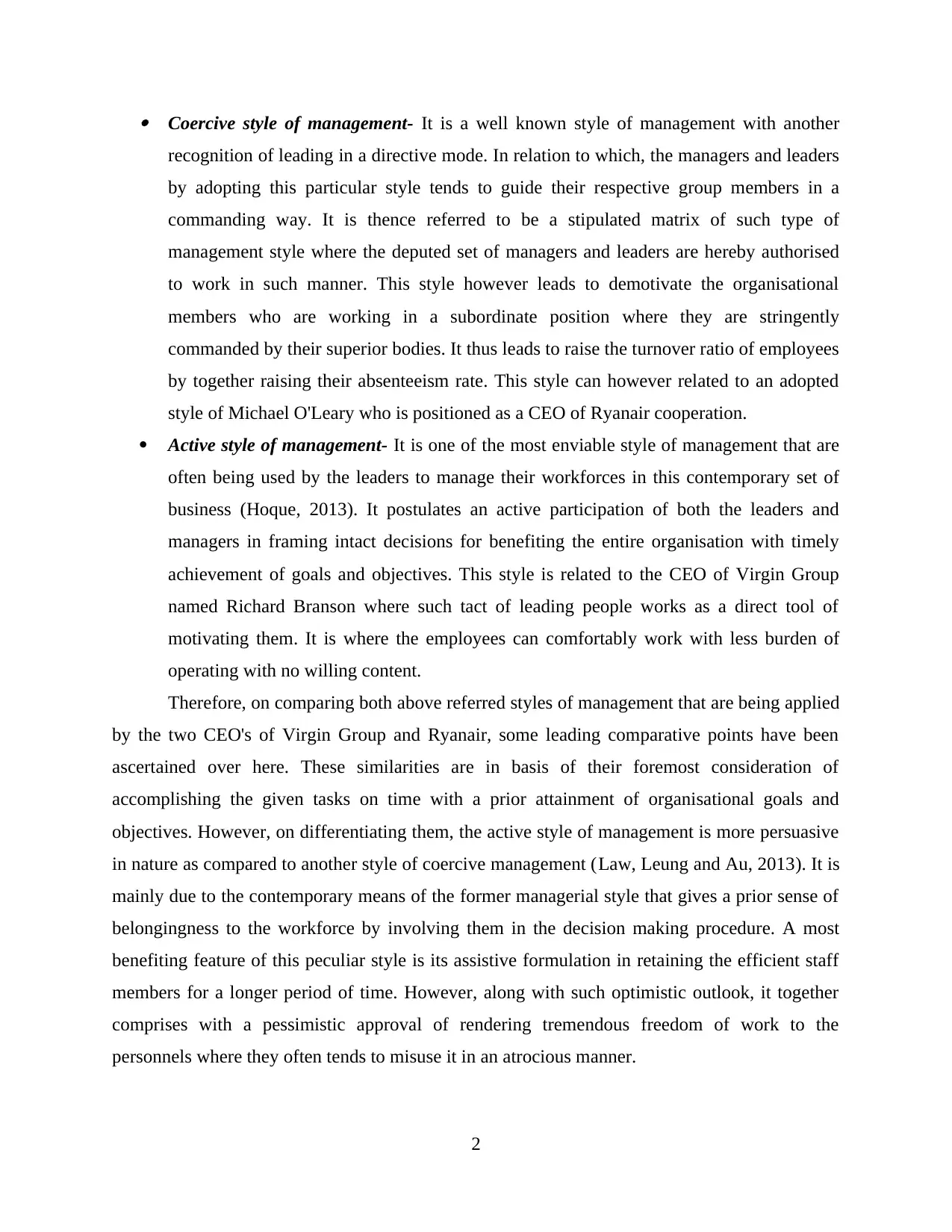
Coercive style of management- It is a well known style of management with another
recognition of leading in a directive mode. In relation to which, the managers and leaders
by adopting this particular style tends to guide their respective group members in a
commanding way. It is thence referred to be a stipulated matrix of such type of
management style where the deputed set of managers and leaders are hereby authorised
to work in such manner. This style however leads to demotivate the organisational
members who are working in a subordinate position where they are stringently
commanded by their superior bodies. It thus leads to raise the turnover ratio of employees
by together raising their absenteeism rate. This style can however related to an adopted
style of Michael O'Leary who is positioned as a CEO of Ryanair cooperation.
Active style of management- It is one of the most enviable style of management that are
often being used by the leaders to manage their workforces in this contemporary set of
business (Hoque, 2013). It postulates an active participation of both the leaders and
managers in framing intact decisions for benefiting the entire organisation with timely
achievement of goals and objectives. This style is related to the CEO of Virgin Group
named Richard Branson where such tact of leading people works as a direct tool of
motivating them. It is where the employees can comfortably work with less burden of
operating with no willing content.
Therefore, on comparing both above referred styles of management that are being applied
by the two CEO's of Virgin Group and Ryanair, some leading comparative points have been
ascertained over here. These similarities are in basis of their foremost consideration of
accomplishing the given tasks on time with a prior attainment of organisational goals and
objectives. However, on differentiating them, the active style of management is more persuasive
in nature as compared to another style of coercive management (Law, Leung and Au, 2013). It is
mainly due to the contemporary means of the former managerial style that gives a prior sense of
belongingness to the workforce by involving them in the decision making procedure. A most
benefiting feature of this peculiar style is its assistive formulation in retaining the efficient staff
members for a longer period of time. However, along with such optimistic outlook, it together
comprises with a pessimistic approval of rendering tremendous freedom of work to the
personnels where they often tends to misuse it in an atrocious manner.
2
recognition of leading in a directive mode. In relation to which, the managers and leaders
by adopting this particular style tends to guide their respective group members in a
commanding way. It is thence referred to be a stipulated matrix of such type of
management style where the deputed set of managers and leaders are hereby authorised
to work in such manner. This style however leads to demotivate the organisational
members who are working in a subordinate position where they are stringently
commanded by their superior bodies. It thus leads to raise the turnover ratio of employees
by together raising their absenteeism rate. This style can however related to an adopted
style of Michael O'Leary who is positioned as a CEO of Ryanair cooperation.
Active style of management- It is one of the most enviable style of management that are
often being used by the leaders to manage their workforces in this contemporary set of
business (Hoque, 2013). It postulates an active participation of both the leaders and
managers in framing intact decisions for benefiting the entire organisation with timely
achievement of goals and objectives. This style is related to the CEO of Virgin Group
named Richard Branson where such tact of leading people works as a direct tool of
motivating them. It is where the employees can comfortably work with less burden of
operating with no willing content.
Therefore, on comparing both above referred styles of management that are being applied
by the two CEO's of Virgin Group and Ryanair, some leading comparative points have been
ascertained over here. These similarities are in basis of their foremost consideration of
accomplishing the given tasks on time with a prior attainment of organisational goals and
objectives. However, on differentiating them, the active style of management is more persuasive
in nature as compared to another style of coercive management (Law, Leung and Au, 2013). It is
mainly due to the contemporary means of the former managerial style that gives a prior sense of
belongingness to the workforce by involving them in the decision making procedure. A most
benefiting feature of this peculiar style is its assistive formulation in retaining the efficient staff
members for a longer period of time. However, along with such optimistic outlook, it together
comprises with a pessimistic approval of rendering tremendous freedom of work to the
personnels where they often tends to misuse it in an atrocious manner.
2
Paraphrase This Document
Need a fresh take? Get an instant paraphrase of this document with our AI Paraphraser
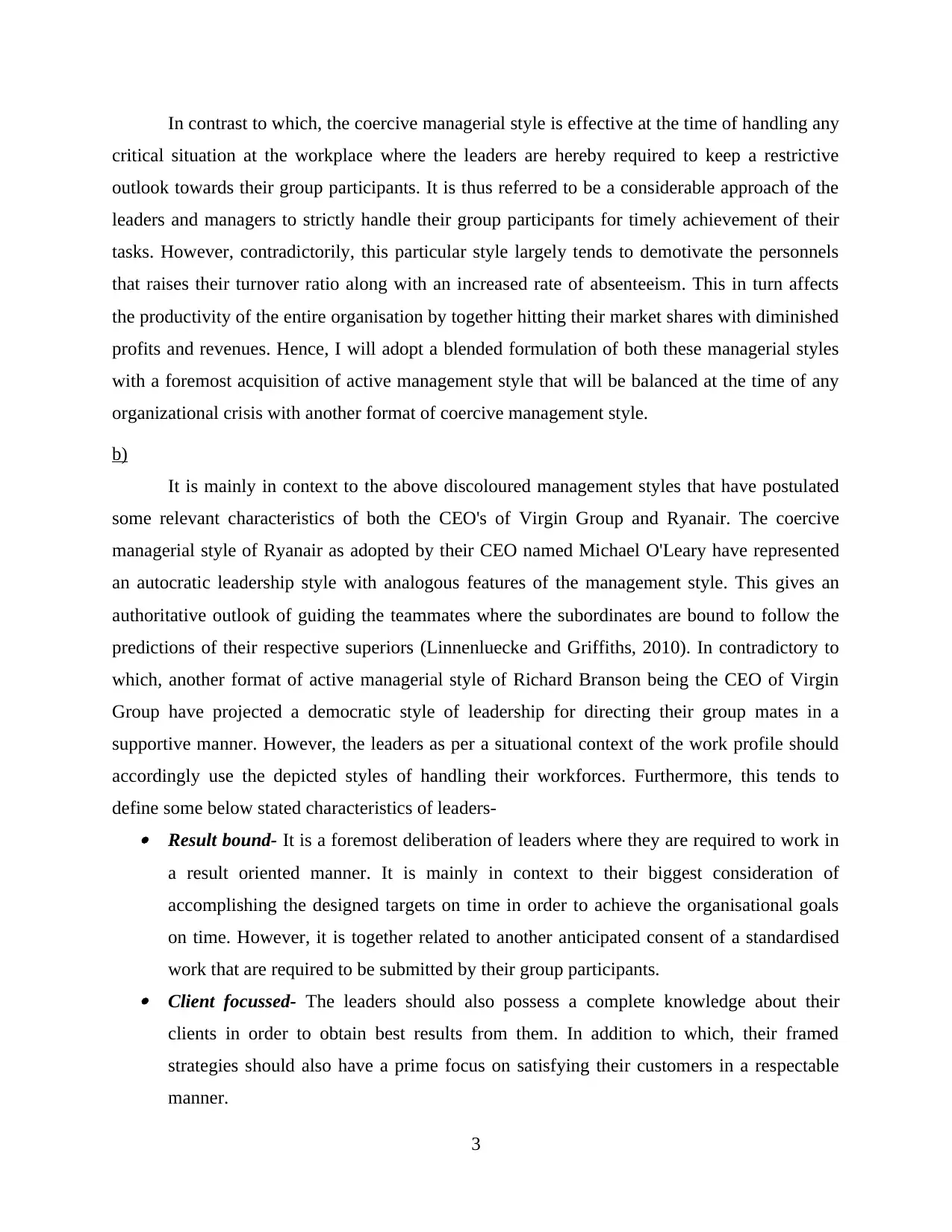
In contrast to which, the coercive managerial style is effective at the time of handling any
critical situation at the workplace where the leaders are hereby required to keep a restrictive
outlook towards their group participants. It is thus referred to be a considerable approach of the
leaders and managers to strictly handle their group participants for timely achievement of their
tasks. However, contradictorily, this particular style largely tends to demotivate the personnels
that raises their turnover ratio along with an increased rate of absenteeism. This in turn affects
the productivity of the entire organisation by together hitting their market shares with diminished
profits and revenues. Hence, I will adopt a blended formulation of both these managerial styles
with a foremost acquisition of active management style that will be balanced at the time of any
organizational crisis with another format of coercive management style.
b)
It is mainly in context to the above discoloured management styles that have postulated
some relevant characteristics of both the CEO's of Virgin Group and Ryanair. The coercive
managerial style of Ryanair as adopted by their CEO named Michael O'Leary have represented
an autocratic leadership style with analogous features of the management style. This gives an
authoritative outlook of guiding the teammates where the subordinates are bound to follow the
predictions of their respective superiors (Linnenluecke and Griffiths, 2010). In contradictory to
which, another format of active managerial style of Richard Branson being the CEO of Virgin
Group have projected a democratic style of leadership for directing their group mates in a
supportive manner. However, the leaders as per a situational context of the work profile should
accordingly use the depicted styles of handling their workforces. Furthermore, this tends to
define some below stated characteristics of leaders- Result bound- It is a foremost deliberation of leaders where they are required to work in
a result oriented manner. It is mainly in context to their biggest consideration of
accomplishing the designed targets on time in order to achieve the organisational goals
on time. However, it is together related to another anticipated consent of a standardised
work that are required to be submitted by their group participants. Client focussed- The leaders should also possess a complete knowledge about their
clients in order to obtain best results from them. In addition to which, their framed
strategies should also have a prime focus on satisfying their customers in a respectable
manner.
3
critical situation at the workplace where the leaders are hereby required to keep a restrictive
outlook towards their group participants. It is thus referred to be a considerable approach of the
leaders and managers to strictly handle their group participants for timely achievement of their
tasks. However, contradictorily, this particular style largely tends to demotivate the personnels
that raises their turnover ratio along with an increased rate of absenteeism. This in turn affects
the productivity of the entire organisation by together hitting their market shares with diminished
profits and revenues. Hence, I will adopt a blended formulation of both these managerial styles
with a foremost acquisition of active management style that will be balanced at the time of any
organizational crisis with another format of coercive management style.
b)
It is mainly in context to the above discoloured management styles that have postulated
some relevant characteristics of both the CEO's of Virgin Group and Ryanair. The coercive
managerial style of Ryanair as adopted by their CEO named Michael O'Leary have represented
an autocratic leadership style with analogous features of the management style. This gives an
authoritative outlook of guiding the teammates where the subordinates are bound to follow the
predictions of their respective superiors (Linnenluecke and Griffiths, 2010). In contradictory to
which, another format of active managerial style of Richard Branson being the CEO of Virgin
Group have projected a democratic style of leadership for directing their group mates in a
supportive manner. However, the leaders as per a situational context of the work profile should
accordingly use the depicted styles of handling their workforces. Furthermore, this tends to
define some below stated characteristics of leaders- Result bound- It is a foremost deliberation of leaders where they are required to work in
a result oriented manner. It is mainly in context to their biggest consideration of
accomplishing the designed targets on time in order to achieve the organisational goals
on time. However, it is together related to another anticipated consent of a standardised
work that are required to be submitted by their group participants. Client focussed- The leaders should also possess a complete knowledge about their
clients in order to obtain best results from them. In addition to which, their framed
strategies should also have a prime focus on satisfying their customers in a respectable
manner.
3
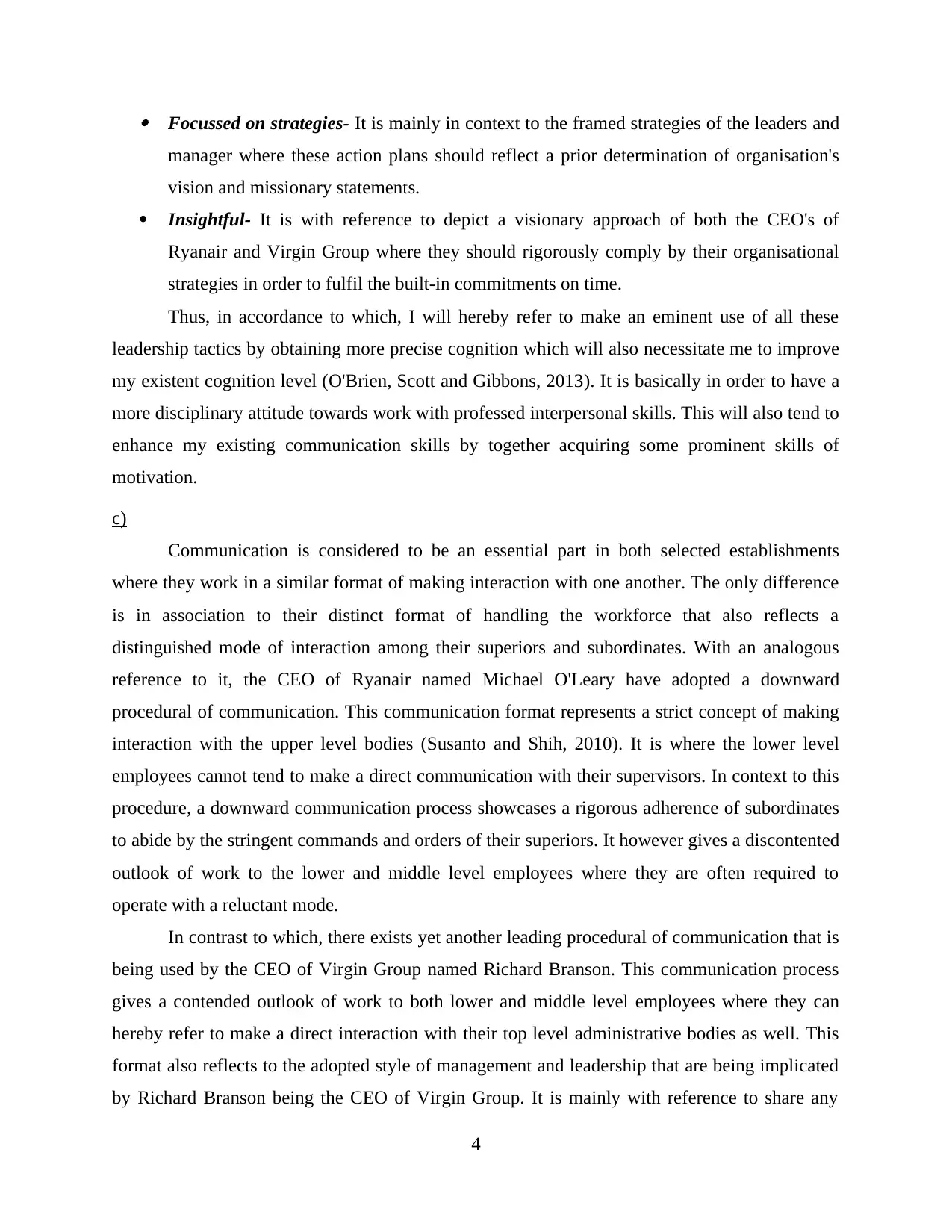
Focussed on strategies- It is mainly in context to the framed strategies of the leaders and
manager where these action plans should reflect a prior determination of organisation's
vision and missionary statements.
Insightful- It is with reference to depict a visionary approach of both the CEO's of
Ryanair and Virgin Group where they should rigorously comply by their organisational
strategies in order to fulfil the built-in commitments on time.
Thus, in accordance to which, I will hereby refer to make an eminent use of all these
leadership tactics by obtaining more precise cognition which will also necessitate me to improve
my existent cognition level (O'Brien, Scott and Gibbons, 2013). It is basically in order to have a
more disciplinary attitude towards work with professed interpersonal skills. This will also tend to
enhance my existing communication skills by together acquiring some prominent skills of
motivation.
c)
Communication is considered to be an essential part in both selected establishments
where they work in a similar format of making interaction with one another. The only difference
is in association to their distinct format of handling the workforce that also reflects a
distinguished mode of interaction among their superiors and subordinates. With an analogous
reference to it, the CEO of Ryanair named Michael O'Leary have adopted a downward
procedural of communication. This communication format represents a strict concept of making
interaction with the upper level bodies (Susanto and Shih, 2010). It is where the lower level
employees cannot tend to make a direct communication with their supervisors. In context to this
procedure, a downward communication process showcases a rigorous adherence of subordinates
to abide by the stringent commands and orders of their superiors. It however gives a discontented
outlook of work to the lower and middle level employees where they are often required to
operate with a reluctant mode.
In contrast to which, there exists yet another leading procedural of communication that is
being used by the CEO of Virgin Group named Richard Branson. This communication process
gives a contended outlook of work to both lower and middle level employees where they can
hereby refer to make a direct interaction with their top level administrative bodies as well. This
format also reflects to the adopted style of management and leadership that are being implicated
by Richard Branson being the CEO of Virgin Group. It is mainly with reference to share any
4
manager where these action plans should reflect a prior determination of organisation's
vision and missionary statements.
Insightful- It is with reference to depict a visionary approach of both the CEO's of
Ryanair and Virgin Group where they should rigorously comply by their organisational
strategies in order to fulfil the built-in commitments on time.
Thus, in accordance to which, I will hereby refer to make an eminent use of all these
leadership tactics by obtaining more precise cognition which will also necessitate me to improve
my existent cognition level (O'Brien, Scott and Gibbons, 2013). It is basically in order to have a
more disciplinary attitude towards work with professed interpersonal skills. This will also tend to
enhance my existing communication skills by together acquiring some prominent skills of
motivation.
c)
Communication is considered to be an essential part in both selected establishments
where they work in a similar format of making interaction with one another. The only difference
is in association to their distinct format of handling the workforce that also reflects a
distinguished mode of interaction among their superiors and subordinates. With an analogous
reference to it, the CEO of Ryanair named Michael O'Leary have adopted a downward
procedural of communication. This communication format represents a strict concept of making
interaction with the upper level bodies (Susanto and Shih, 2010). It is where the lower level
employees cannot tend to make a direct communication with their supervisors. In context to this
procedure, a downward communication process showcases a rigorous adherence of subordinates
to abide by the stringent commands and orders of their superiors. It however gives a discontented
outlook of work to the lower and middle level employees where they are often required to
operate with a reluctant mode.
In contrast to which, there exists yet another leading procedural of communication that is
being used by the CEO of Virgin Group named Richard Branson. This communication process
gives a contended outlook of work to both lower and middle level employees where they can
hereby refer to make a direct interaction with their top level administrative bodies as well. This
format also reflects to the adopted style of management and leadership that are being implicated
by Richard Branson being the CEO of Virgin Group. It is mainly with reference to share any
4
⊘ This is a preview!⊘
Do you want full access?
Subscribe today to unlock all pages.

Trusted by 1+ million students worldwide
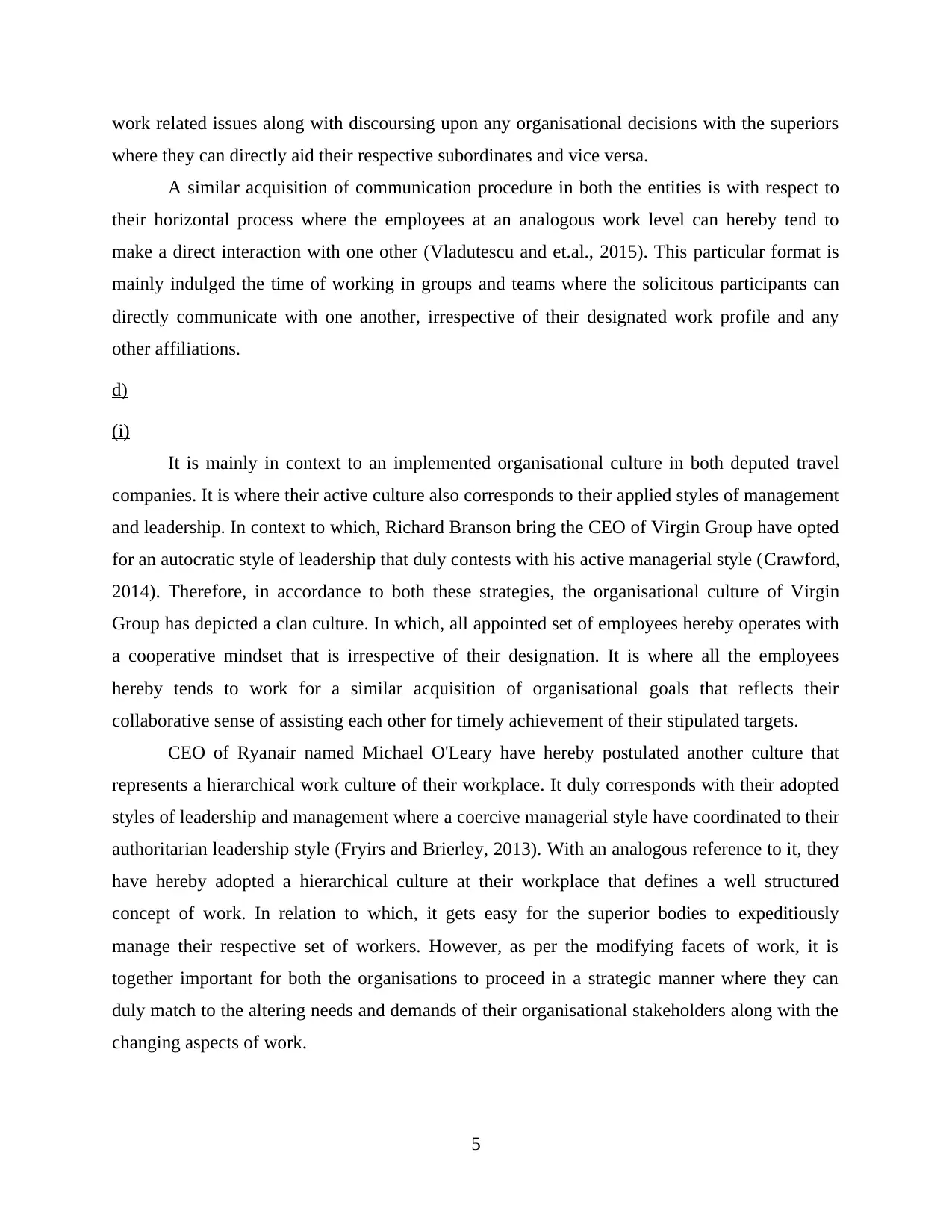
work related issues along with discoursing upon any organisational decisions with the superiors
where they can directly aid their respective subordinates and vice versa.
A similar acquisition of communication procedure in both the entities is with respect to
their horizontal process where the employees at an analogous work level can hereby tend to
make a direct interaction with one other (Vladutescu and et.al., 2015). This particular format is
mainly indulged the time of working in groups and teams where the solicitous participants can
directly communicate with one another, irrespective of their designated work profile and any
other affiliations.
d)
(i)
It is mainly in context to an implemented organisational culture in both deputed travel
companies. It is where their active culture also corresponds to their applied styles of management
and leadership. In context to which, Richard Branson bring the CEO of Virgin Group have opted
for an autocratic style of leadership that duly contests with his active managerial style (Crawford,
2014). Therefore, in accordance to both these strategies, the organisational culture of Virgin
Group has depicted a clan culture. In which, all appointed set of employees hereby operates with
a cooperative mindset that is irrespective of their designation. It is where all the employees
hereby tends to work for a similar acquisition of organisational goals that reflects their
collaborative sense of assisting each other for timely achievement of their stipulated targets.
CEO of Ryanair named Michael O'Leary have hereby postulated another culture that
represents a hierarchical work culture of their workplace. It duly corresponds with their adopted
styles of leadership and management where a coercive managerial style have coordinated to their
authoritarian leadership style (Fryirs and Brierley, 2013). With an analogous reference to it, they
have hereby adopted a hierarchical culture at their workplace that defines a well structured
concept of work. In relation to which, it gets easy for the superior bodies to expeditiously
manage their respective set of workers. However, as per the modifying facets of work, it is
together important for both the organisations to proceed in a strategic manner where they can
duly match to the altering needs and demands of their organisational stakeholders along with the
changing aspects of work.
5
where they can directly aid their respective subordinates and vice versa.
A similar acquisition of communication procedure in both the entities is with respect to
their horizontal process where the employees at an analogous work level can hereby tend to
make a direct interaction with one other (Vladutescu and et.al., 2015). This particular format is
mainly indulged the time of working in groups and teams where the solicitous participants can
directly communicate with one another, irrespective of their designated work profile and any
other affiliations.
d)
(i)
It is mainly in context to an implemented organisational culture in both deputed travel
companies. It is where their active culture also corresponds to their applied styles of management
and leadership. In context to which, Richard Branson bring the CEO of Virgin Group have opted
for an autocratic style of leadership that duly contests with his active managerial style (Crawford,
2014). Therefore, in accordance to both these strategies, the organisational culture of Virgin
Group has depicted a clan culture. In which, all appointed set of employees hereby operates with
a cooperative mindset that is irrespective of their designation. It is where all the employees
hereby tends to work for a similar acquisition of organisational goals that reflects their
collaborative sense of assisting each other for timely achievement of their stipulated targets.
CEO of Ryanair named Michael O'Leary have hereby postulated another culture that
represents a hierarchical work culture of their workplace. It duly corresponds with their adopted
styles of leadership and management where a coercive managerial style have coordinated to their
authoritarian leadership style (Fryirs and Brierley, 2013). With an analogous reference to it, they
have hereby adopted a hierarchical culture at their workplace that defines a well structured
concept of work. In relation to which, it gets easy for the superior bodies to expeditiously
manage their respective set of workers. However, as per the modifying facets of work, it is
together important for both the organisations to proceed in a strategic manner where they can
duly match to the altering needs and demands of their organisational stakeholders along with the
changing aspects of work.
5
Paraphrase This Document
Need a fresh take? Get an instant paraphrase of this document with our AI Paraphraser
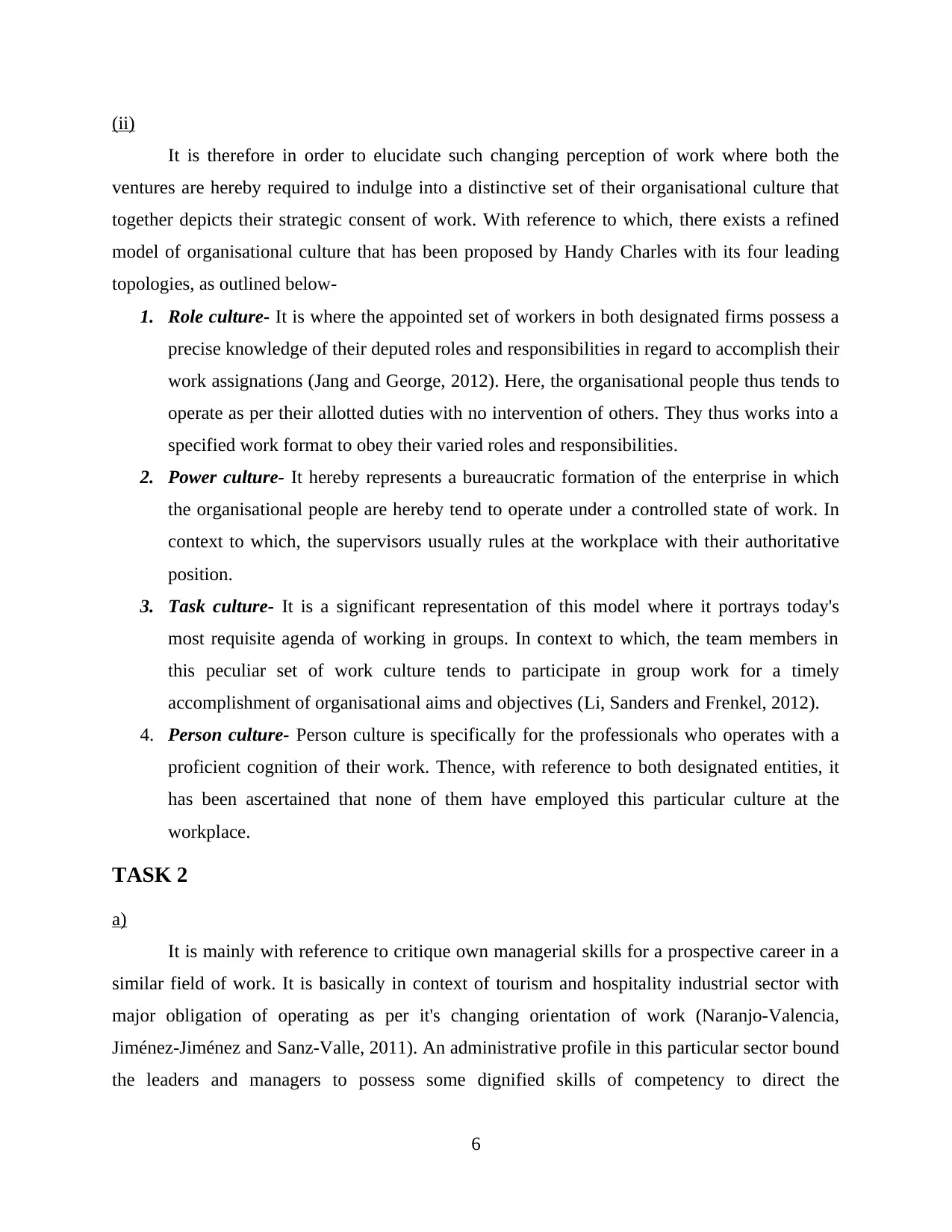
(ii)
It is therefore in order to elucidate such changing perception of work where both the
ventures are hereby required to indulge into a distinctive set of their organisational culture that
together depicts their strategic consent of work. With reference to which, there exists a refined
model of organisational culture that has been proposed by Handy Charles with its four leading
topologies, as outlined below-
1. Role culture- It is where the appointed set of workers in both designated firms possess a
precise knowledge of their deputed roles and responsibilities in regard to accomplish their
work assignations (Jang and George, 2012). Here, the organisational people thus tends to
operate as per their allotted duties with no intervention of others. They thus works into a
specified work format to obey their varied roles and responsibilities.
2. Power culture- It hereby represents a bureaucratic formation of the enterprise in which
the organisational people are hereby tend to operate under a controlled state of work. In
context to which, the supervisors usually rules at the workplace with their authoritative
position.
3. Task culture- It is a significant representation of this model where it portrays today's
most requisite agenda of working in groups. In context to which, the team members in
this peculiar set of work culture tends to participate in group work for a timely
accomplishment of organisational aims and objectives (Li, Sanders and Frenkel, 2012).
4. Person culture- Person culture is specifically for the professionals who operates with a
proficient cognition of their work. Thence, with reference to both designated entities, it
has been ascertained that none of them have employed this particular culture at the
workplace.
TASK 2
a)
It is mainly with reference to critique own managerial skills for a prospective career in a
similar field of work. It is basically in context of tourism and hospitality industrial sector with
major obligation of operating as per it's changing orientation of work (Naranjo-Valencia,
Jiménez-Jiménez and Sanz-Valle, 2011). An administrative profile in this particular sector bound
the leaders and managers to possess some dignified skills of competency to direct the
6
It is therefore in order to elucidate such changing perception of work where both the
ventures are hereby required to indulge into a distinctive set of their organisational culture that
together depicts their strategic consent of work. With reference to which, there exists a refined
model of organisational culture that has been proposed by Handy Charles with its four leading
topologies, as outlined below-
1. Role culture- It is where the appointed set of workers in both designated firms possess a
precise knowledge of their deputed roles and responsibilities in regard to accomplish their
work assignations (Jang and George, 2012). Here, the organisational people thus tends to
operate as per their allotted duties with no intervention of others. They thus works into a
specified work format to obey their varied roles and responsibilities.
2. Power culture- It hereby represents a bureaucratic formation of the enterprise in which
the organisational people are hereby tend to operate under a controlled state of work. In
context to which, the supervisors usually rules at the workplace with their authoritative
position.
3. Task culture- It is a significant representation of this model where it portrays today's
most requisite agenda of working in groups. In context to which, the team members in
this peculiar set of work culture tends to participate in group work for a timely
accomplishment of organisational aims and objectives (Li, Sanders and Frenkel, 2012).
4. Person culture- Person culture is specifically for the professionals who operates with a
proficient cognition of their work. Thence, with reference to both designated entities, it
has been ascertained that none of them have employed this particular culture at the
workplace.
TASK 2
a)
It is mainly with reference to critique own managerial skills for a prospective career in a
similar field of work. It is basically in context of tourism and hospitality industrial sector with
major obligation of operating as per it's changing orientation of work (Naranjo-Valencia,
Jiménez-Jiménez and Sanz-Valle, 2011). An administrative profile in this particular sector bound
the leaders and managers to possess some dignified skills of competency to direct the
6
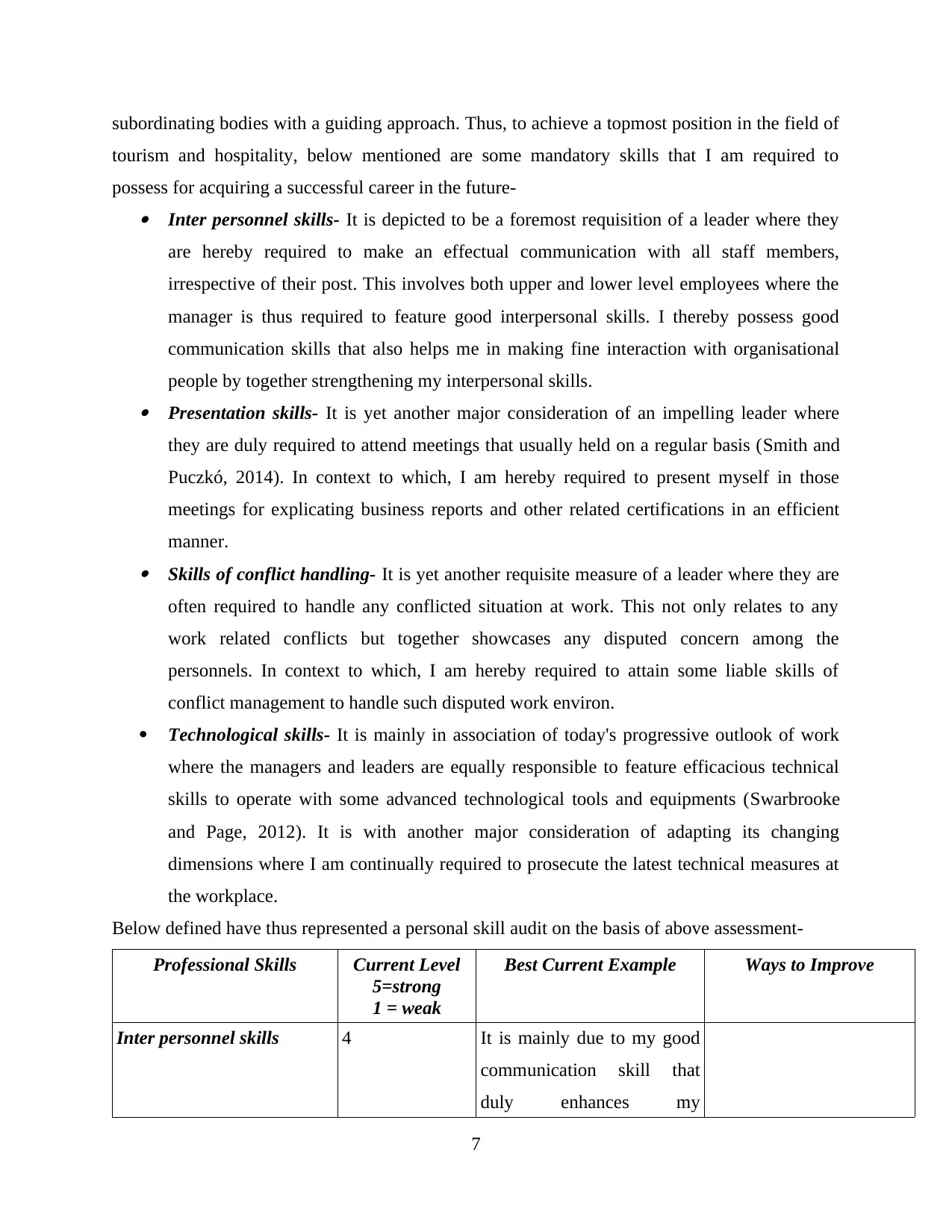
subordinating bodies with a guiding approach. Thus, to achieve a topmost position in the field of
tourism and hospitality, below mentioned are some mandatory skills that I am required to
possess for acquiring a successful career in the future- Inter personnel skills- It is depicted to be a foremost requisition of a leader where they
are hereby required to make an effectual communication with all staff members,
irrespective of their post. This involves both upper and lower level employees where the
manager is thus required to feature good interpersonal skills. I thereby possess good
communication skills that also helps me in making fine interaction with organisational
people by together strengthening my interpersonal skills. Presentation skills- It is yet another major consideration of an impelling leader where
they are duly required to attend meetings that usually held on a regular basis (Smith and
Puczkó, 2014). In context to which, I am hereby required to present myself in those
meetings for explicating business reports and other related certifications in an efficient
manner. Skills of conflict handling- It is yet another requisite measure of a leader where they are
often required to handle any conflicted situation at work. This not only relates to any
work related conflicts but together showcases any disputed concern among the
personnels. In context to which, I am hereby required to attain some liable skills of
conflict management to handle such disputed work environ.
Technological skills- It is mainly in association of today's progressive outlook of work
where the managers and leaders are equally responsible to feature efficacious technical
skills to operate with some advanced technological tools and equipments (Swarbrooke
and Page, 2012). It is with another major consideration of adapting its changing
dimensions where I am continually required to prosecute the latest technical measures at
the workplace.
Below defined have thus represented a personal skill audit on the basis of above assessment-
Professional Skills Current Level
5=strong
1 = weak
Best Current Example Ways to Improve
Inter personnel skills 4 It is mainly due to my good
communication skill that
duly enhances my
7
tourism and hospitality, below mentioned are some mandatory skills that I am required to
possess for acquiring a successful career in the future- Inter personnel skills- It is depicted to be a foremost requisition of a leader where they
are hereby required to make an effectual communication with all staff members,
irrespective of their post. This involves both upper and lower level employees where the
manager is thus required to feature good interpersonal skills. I thereby possess good
communication skills that also helps me in making fine interaction with organisational
people by together strengthening my interpersonal skills. Presentation skills- It is yet another major consideration of an impelling leader where
they are duly required to attend meetings that usually held on a regular basis (Smith and
Puczkó, 2014). In context to which, I am hereby required to present myself in those
meetings for explicating business reports and other related certifications in an efficient
manner. Skills of conflict handling- It is yet another requisite measure of a leader where they are
often required to handle any conflicted situation at work. This not only relates to any
work related conflicts but together showcases any disputed concern among the
personnels. In context to which, I am hereby required to attain some liable skills of
conflict management to handle such disputed work environ.
Technological skills- It is mainly in association of today's progressive outlook of work
where the managers and leaders are equally responsible to feature efficacious technical
skills to operate with some advanced technological tools and equipments (Swarbrooke
and Page, 2012). It is with another major consideration of adapting its changing
dimensions where I am continually required to prosecute the latest technical measures at
the workplace.
Below defined have thus represented a personal skill audit on the basis of above assessment-
Professional Skills Current Level
5=strong
1 = weak
Best Current Example Ways to Improve
Inter personnel skills 4 It is mainly due to my good
communication skill that
duly enhances my
7
⊘ This is a preview!⊘
Do you want full access?
Subscribe today to unlock all pages.

Trusted by 1+ million students worldwide
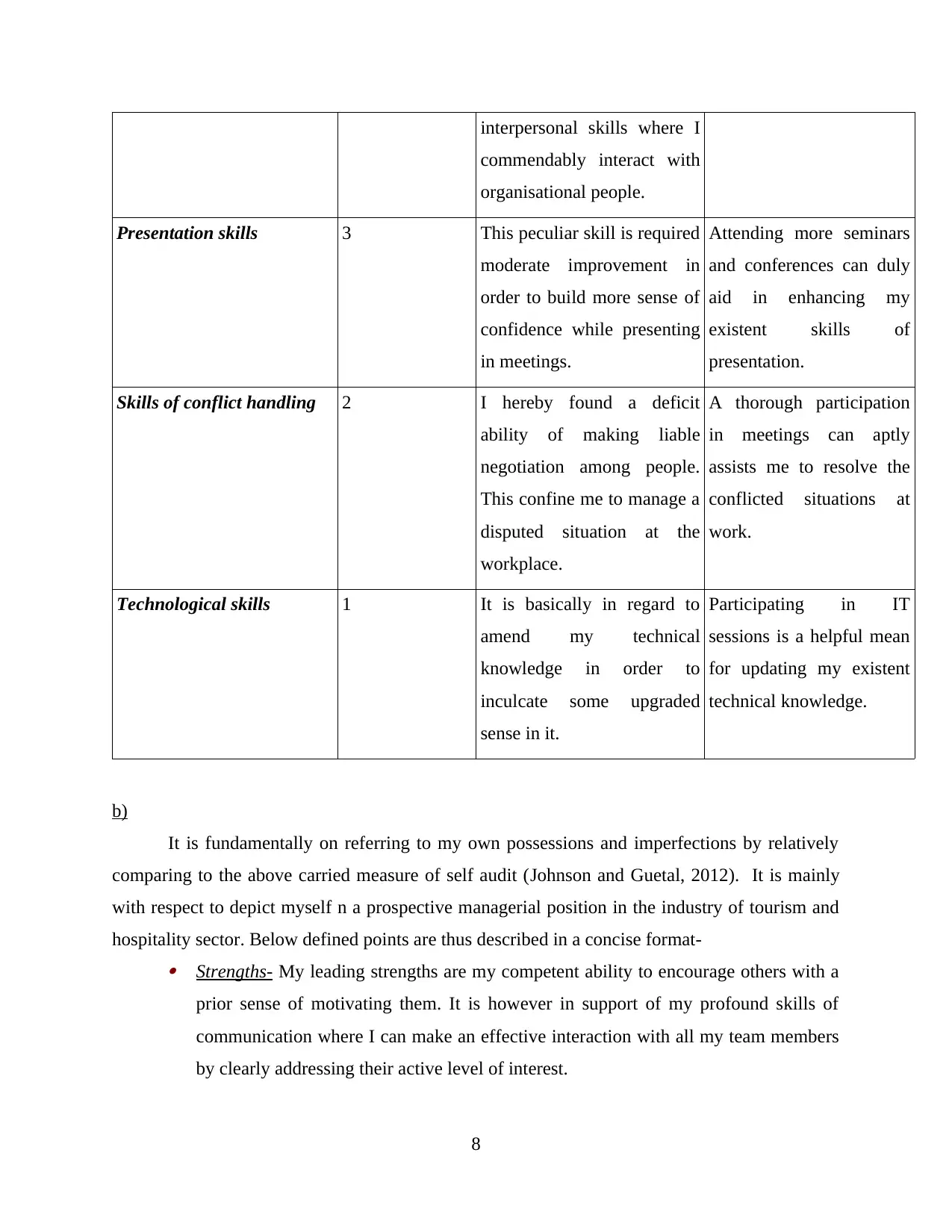
interpersonal skills where I
commendably interact with
organisational people.
Presentation skills 3 This peculiar skill is required
moderate improvement in
order to build more sense of
confidence while presenting
in meetings.
Attending more seminars
and conferences can duly
aid in enhancing my
existent skills of
presentation.
Skills of conflict handling 2 I hereby found a deficit
ability of making liable
negotiation among people.
This confine me to manage a
disputed situation at the
workplace.
A thorough participation
in meetings can aptly
assists me to resolve the
conflicted situations at
work.
Technological skills 1 It is basically in regard to
amend my technical
knowledge in order to
inculcate some upgraded
sense in it.
Participating in IT
sessions is a helpful mean
for updating my existent
technical knowledge.
b)
It is fundamentally on referring to my own possessions and imperfections by relatively
comparing to the above carried measure of self audit (Johnson and Guetal, 2012). It is mainly
with respect to depict myself n a prospective managerial position in the industry of tourism and
hospitality sector. Below defined points are thus described in a concise format-
Strengths- My leading strengths are my competent ability to encourage others with a
prior sense of motivating them. It is however in support of my profound skills of
communication where I can make an effective interaction with all my team members
by clearly addressing their active level of interest.
8
commendably interact with
organisational people.
Presentation skills 3 This peculiar skill is required
moderate improvement in
order to build more sense of
confidence while presenting
in meetings.
Attending more seminars
and conferences can duly
aid in enhancing my
existent skills of
presentation.
Skills of conflict handling 2 I hereby found a deficit
ability of making liable
negotiation among people.
This confine me to manage a
disputed situation at the
workplace.
A thorough participation
in meetings can aptly
assists me to resolve the
conflicted situations at
work.
Technological skills 1 It is basically in regard to
amend my technical
knowledge in order to
inculcate some upgraded
sense in it.
Participating in IT
sessions is a helpful mean
for updating my existent
technical knowledge.
b)
It is fundamentally on referring to my own possessions and imperfections by relatively
comparing to the above carried measure of self audit (Johnson and Guetal, 2012). It is mainly
with respect to depict myself n a prospective managerial position in the industry of tourism and
hospitality sector. Below defined points are thus described in a concise format-
Strengths- My leading strengths are my competent ability to encourage others with a
prior sense of motivating them. It is however in support of my profound skills of
communication where I can make an effective interaction with all my team members
by clearly addressing their active level of interest.
8
Paraphrase This Document
Need a fresh take? Get an instant paraphrase of this document with our AI Paraphraser
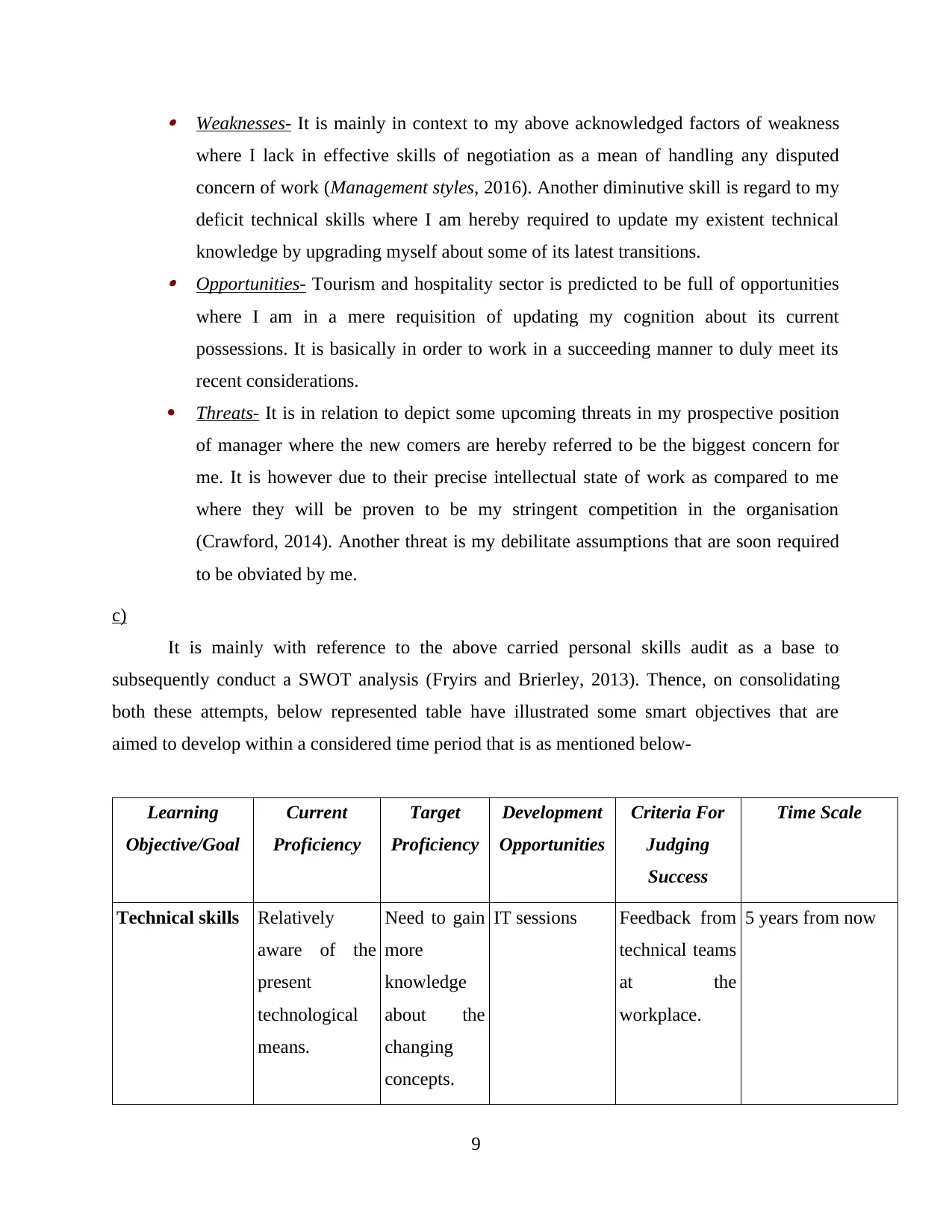
Weaknesses- It is mainly in context to my above acknowledged factors of weakness
where I lack in effective skills of negotiation as a mean of handling any disputed
concern of work (Management styles, 2016). Another diminutive skill is regard to my
deficit technical skills where I am hereby required to update my existent technical
knowledge by upgrading myself about some of its latest transitions.
Opportunities- Tourism and hospitality sector is predicted to be full of opportunities
where I am in a mere requisition of updating my cognition about its current
possessions. It is basically in order to work in a succeeding manner to duly meet its
recent considerations.
Threats- It is in relation to depict some upcoming threats in my prospective position
of manager where the new comers are hereby referred to be the biggest concern for
me. It is however due to their precise intellectual state of work as compared to me
where they will be proven to be my stringent competition in the organisation
(Crawford, 2014). Another threat is my debilitate assumptions that are soon required
to be obviated by me.
c)
It is mainly with reference to the above carried personal skills audit as a base to
subsequently conduct a SWOT analysis (Fryirs and Brierley, 2013). Thence, on consolidating
both these attempts, below represented table have illustrated some smart objectives that are
aimed to develop within a considered time period that is as mentioned below-
Learning
Objective/Goal
Current
Proficiency
Target
Proficiency
Development
Opportunities
Criteria For
Judging
Success
Time Scale
Technical skills Relatively
aware of the
present
technological
means.
Need to gain
more
knowledge
about the
changing
concepts.
IT sessions Feedback from
technical teams
at the
workplace.
5 years from now
9
where I lack in effective skills of negotiation as a mean of handling any disputed
concern of work (Management styles, 2016). Another diminutive skill is regard to my
deficit technical skills where I am hereby required to update my existent technical
knowledge by upgrading myself about some of its latest transitions.
Opportunities- Tourism and hospitality sector is predicted to be full of opportunities
where I am in a mere requisition of updating my cognition about its current
possessions. It is basically in order to work in a succeeding manner to duly meet its
recent considerations.
Threats- It is in relation to depict some upcoming threats in my prospective position
of manager where the new comers are hereby referred to be the biggest concern for
me. It is however due to their precise intellectual state of work as compared to me
where they will be proven to be my stringent competition in the organisation
(Crawford, 2014). Another threat is my debilitate assumptions that are soon required
to be obviated by me.
c)
It is mainly with reference to the above carried personal skills audit as a base to
subsequently conduct a SWOT analysis (Fryirs and Brierley, 2013). Thence, on consolidating
both these attempts, below represented table have illustrated some smart objectives that are
aimed to develop within a considered time period that is as mentioned below-
Learning
Objective/Goal
Current
Proficiency
Target
Proficiency
Development
Opportunities
Criteria For
Judging
Success
Time Scale
Technical skills Relatively
aware of the
present
technological
means.
Need to gain
more
knowledge
about the
changing
concepts.
IT sessions Feedback from
technical teams
at the
workplace.
5 years from now
9
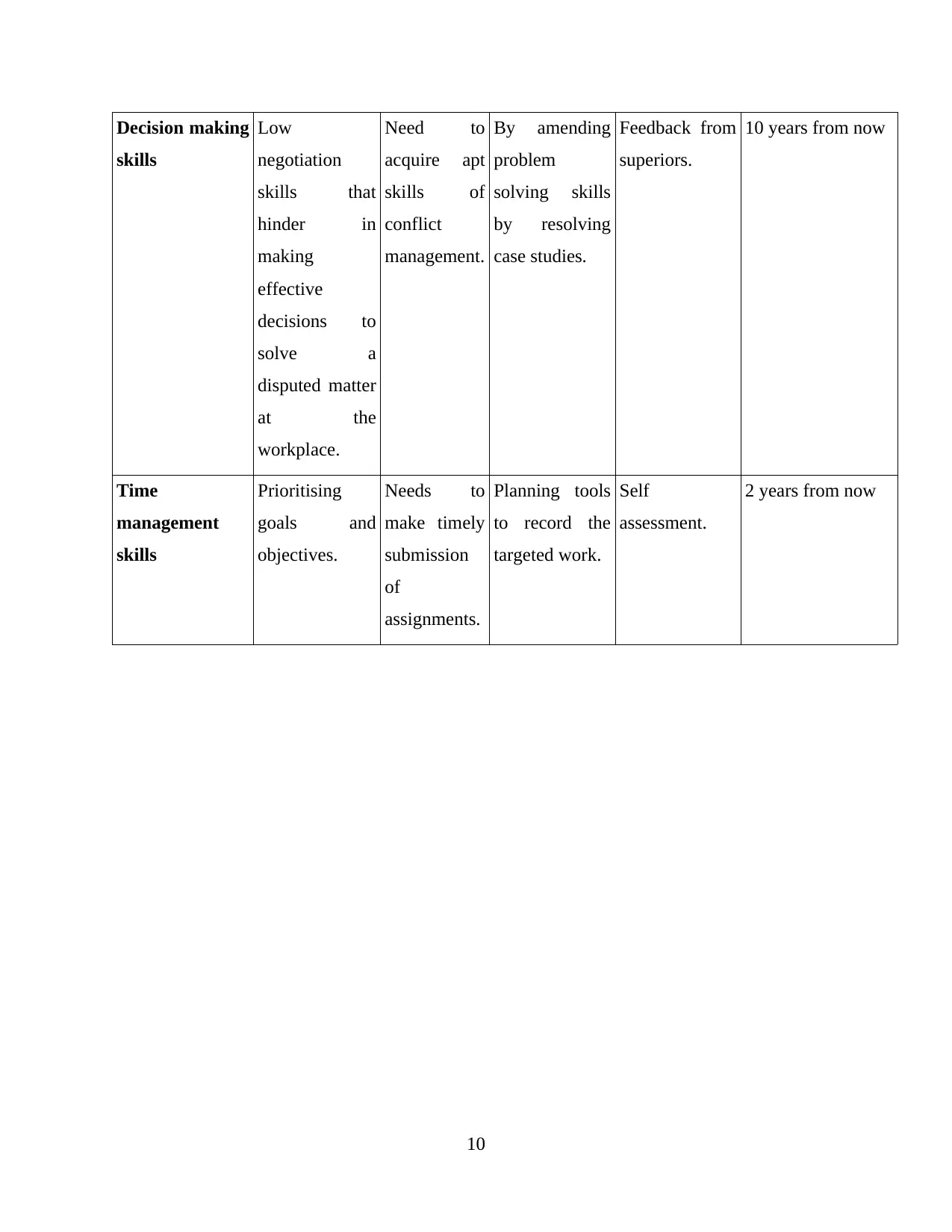
Decision making
skills
Low
negotiation
skills that
hinder in
making
effective
decisions to
solve a
disputed matter
at the
workplace.
Need to
acquire apt
skills of
conflict
management.
By amending
problem
solving skills
by resolving
case studies.
Feedback from
superiors.
10 years from now
Time
management
skills
Prioritising
goals and
objectives.
Needs to
make timely
submission
of
assignments.
Planning tools
to record the
targeted work.
Self
assessment.
2 years from now
10
skills
Low
negotiation
skills that
hinder in
making
effective
decisions to
solve a
disputed matter
at the
workplace.
Need to
acquire apt
skills of
conflict
management.
By amending
problem
solving skills
by resolving
case studies.
Feedback from
superiors.
10 years from now
Time
management
skills
Prioritising
goals and
objectives.
Needs to
make timely
submission
of
assignments.
Planning tools
to record the
targeted work.
Self
assessment.
2 years from now
10
⊘ This is a preview!⊘
Do you want full access?
Subscribe today to unlock all pages.

Trusted by 1+ million students worldwide
1 out of 19
Related Documents
Your All-in-One AI-Powered Toolkit for Academic Success.
+13062052269
info@desklib.com
Available 24*7 on WhatsApp / Email
![[object Object]](/_next/static/media/star-bottom.7253800d.svg)
Unlock your academic potential
Copyright © 2020–2025 A2Z Services. All Rights Reserved. Developed and managed by ZUCOL.





